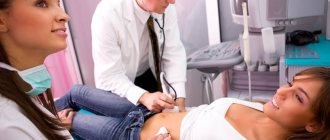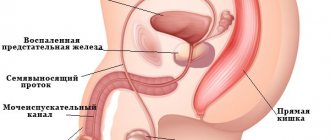Pain in the lower abdomen in men is associated primarily with inflammatory processes in the organs of the urogenital tract and digestive disorders. Men pay less attention to their diet and make mistakes in nutrition, which affects the condition of the gastrointestinal tract. A sedentary lifestyle, drinking large doses of alcohol, smoking, and chronic stress have a negative impact on intestinal function. Disturbances in the functioning of the bladder, kidneys, and urinary canal can be caused by poor personal hygiene, hypothermia, and unprotected sexual intercourse.
The nature of pain in such localization may vary. With intestinal pathologies, the pain syndrome is most often nagging, caused by spasms of the intestinal walls. With infectious lesions of the bladder and organs of the reproductive system, the pain is usually sharp, stabbing, accompanied by cutting and severe burning. To determine exactly what exactly caused the discomfort, a man will have to undergo an examination. In most cases, consultation with highly specialized specialists may be required: andrologist, urologist, gastroenterologist. If the symptoms are vague, the man will be offered an examination by a proctologist and oncologist-surgeon.
Pain in the right lower abdomen in men
Prostatitis is the most common cause
In almost half of the cases, the appearance of pain in the lower abdomen on the right side is associated with acute or chronic inflammation of the prostate. The prostate (or prostate gland) is a tube covered with alveolar tissue and consisting of glandular fibers. The prostate gland is located between the bladder and the pelvic diaphragm and is responsible for the production of a special secretion - one of the main chemical components of the ejaculatory fluid.
Inflammation of the prostate tissue is called prostatitis. It can be acute or chronic. Acute inflammation of the prostate is very rare - most often the pathology has a chronic asymptomatic course with periodic periods of exacerbation, which occur 1-2 times a year under the influence of negative factors.
Prostate inflammation
Signs of chronic pathology include:
- moderate nagging pain just above the pubis, and may also have a right-sided localization;
- pain, burning and discomfort when emptying the bladder (less often, similar symptoms appear during bowel movements);
- constant desire to go to the toilet;
- sexual disorders (weakness of potency, premature ejaculation, difficulty achieving orgasm).
Symptoms of prostatitis
Very often, pain in the lower abdomen is accompanied by acute pain in the groin, scrotum, and penis. With an infectious lesion, pain can radiate to the anus, lower back and sacrococcygeal area.
Important! If you ignore the symptoms of prostatitis and delay treatment, severe complications may develop, for example, prostate adenoma - a benign formation that occurs as a result of pathological growth of the organ. About 30% of men without treatment for the disease subsequently experience impotence and infertility.
Symptoms, prevention, causes and treatment of prostate
Urolithiasis in men
Urolithiasis is a pathology in which stones form in the kidneys and bladder. Concretions are dense formations in the form of stones, mainly consisting of organic salts. If a man is diagnosed with right-sided urolithiasis (the medical name for the disease), he will feel a sharp and cutting pain in the right side of the lower abdomen.
Stones in the ureters
Other signs of urolithiasis in men are:
- painful sensations during intimacy when the man is on top;
- nausea that appears at any time of the day and does not depend on food intake;
- frequent and painful urination;
- attacks of renal colic;
- nagging pain of high intensity in the lumbar region and gluteal muscles.
Any factors can provoke an exacerbation of urolithiasis, but most often such symptoms are caused by poor diet with a high content of salt and animal fats, physical activity, taking certain medications or alcohol abuse.
Clinic of urolithiasis
Important! Similar symptoms are characteristic of other disorders of the urinary system, for example, cystitis and pyelonephritis. With glomerulonephritis - inflammation of the renal glomeruli of an infectious, allergic or autoimmune nature - pain may be accompanied by swelling of the lower extremities, increased blood pressure and decreased daily diuresis.
https://youtu.be/kg1mINGa008
Liver pathology
If the lower abdomen on the right side hurts moderately, this may indicate pathologies occurring in the liver. The organ does not have nerve endings, therefore it itself does not hurt. As a result of inflammation, the size of the liver increases, and it begins to put pressure on neighboring organs, which leads to pain in the right side.
Deterioration in function is indicated by yellowing of the sclera and skin, indigestion, low-grade fever, and changes in the color of feces and urine. If there is an abscess, then sweating increases and muscle discomfort appears.
Pain from inguinal hernia
Inguinal hernias occur in approximately 11% of men. In most cases, the pathology occurs and is detected in childhood and adolescence, but if it is asymptomatic and the size of the protrusion is too small, an inguinal hernia can only be detected at an older age. Conservative treatment at this stage will be ineffective, therefore the use of various fixing bandages and bandages in adult men does not provide any therapeutic results.
Inguinal hernia in men
Hernias can usually occur due to weakness of the ligaments and muscles in the abdominal area or, conversely, with constant tension in the abdominal muscles (for example, during sports or during work involving the regular carrying of heavy weights). Inguinal hernias are usually located in the inguinal canal, an anatomical area not exceeding 6 cm in length in which the spermatic cord is located in an adult male. In boys, during intrauterine growth, the testicles descend into the inguinal canal.
If the protrusion is large, it can be noticed visually. If it is small in size, you can suspect an inguinal canal hernia based on the following signs:
- nagging pain in the right side of the abdomen that occurs during physical activity;
- increased pain when coughing or sneezing;
- swelling of the scrotal tissue.
Types of inguinal hernia
Treatment of groin and scrotal hernias is always surgical.
Note! If the listed symptoms are accompanied by a sharp increase in body temperature, pain when pressing the protrusion, redness of the skin in the area where the formation is localized, acute pain during urination and bowel movements, it is necessary to urgently call an ambulance. This clinical picture is characteristic of a strangulated hernia, a dangerous condition in which the hernial orifice narrows. If the patient is not promptly provided with surgical care, hernial contents may leak into the peritoneum (acute peritonitis) and blood poisoning.
Appendicitis
Almost every adult knows the location of internal organs in the body. The situation is more complicated with the localization of the gastrointestinal tract. The intestine, 4-5 meters long, is compactly located in the human stomach. The topographic landmark of the projection of the appendix is as follows - it is located where two lines intersect:
- horizontal, from the navel and around the abdomen;
- vertical, from the right breast nipple downwards.
Not everyone knows which side a person has appendicitis on. The area that is located to the right of the vertical line and just below the horizontal line to the right leg and groin is called the right iliac region. This is the most likely projection of the appendix.
Moreover, it is not the only one; the process often moves. Before performing surgery, the doctor determines the location of the organ using ultrasound.
The most well-known symptom of appendicitis is severe abdominal pain. How does an attack develop?
- It begins with sudden pain in the solar plexus or above the navel. During this period, pain may also not have a specific localization. Differs in varying intensity and character. Next, the emphasis of pain shifts to the right iliac region. It becomes constant, with moderate intensity, intensifies with movement.
- Accompanied by vomiting, often once - this is a reaction to pain.
- Fever. The temperature is not too high - 37-38 degrees.
- Dyspepsia. There is a disorder in the act of defecation - constipation or diarrhea. There is frequent urination. Urine of intense dark color.
Pseudotuberculosis: how does pain manifest in this disease?
Pseudotuberculosis is an infectious disease that always has an acute course and is caused by Yersinia. These are gram-negative bacteria belonging to the family of anaerobic enterobacteria, having a rod shape. The medical name of the disease is yersiniosis. Externally, the disease is very similar to scarlet fever, often accompanied by systemic fever and a pinpoint red rash.
What is yersiniosis
Pseudotuberculosis in men most often affects the cells of the liver and small intestine. Signs of the disease are:
- rash in the form of small red dots on the legs, abdomen, buttocks and inner thighs;
- temperature rise to 39°-40°;
- fever;
- chills;
- pain in the lower abdomen (if the liver is affected, pain will be detected on the right side);
- severe intoxication (nausea, vomiting, headache).
Forms and symptoms of yersiniosis
Important! Treatment of pseudotuberculosis should be carried out in a hospital setting. Unlike a true tuberculosis infection, the patient does not need to go to a tuberculosis dispensary and be observed by a TB doctor: therapy is selected and carried out in the infectious diseases department of a regular hospital.
Where does colorectal cancer hurt in men?
Pain in the lower abdomen can also occur with certain intestinal disorders and diseases. Most often it appears in the presence of polyps or inflammatory processes in the cecum. Benign intestinal tumors can also cause moderate nagging pain in the lower abdomen on the right if they are located on the right side. If pain appears regularly, it is important to consult a doctor, since in some cases it is periodic mild pain (pulling or cramping) that is the first sign of an oncological process.
Stages of bowel cancer
In the early stages, the disease may not manifest itself in any way, but if the tumor reaches a significant size and the process of metastasis to organs and tissues begins, the manifestations of intestinal cancer will be more obvious. These include:
- bleeding from the anus;
- pain during bowel movements;
- chronic constipation;
- mucus and uncharacteristic streaks in the stool;
- change in the color of stool (stool becomes dark, black or bluish);
- temperature fluctuations within 37°-37.5°;
- stable increase in basal temperature;
- weight loss and decreased appetite.
Development of a cancerous tumor
Important! Colon cancer is one of the most severe types of cancer. The disease has a rapid course and an extremely unfavorable life prognosis, so it is important to seek help for any pathological changes.
How to treat the gallbladder
Most often, the only treatment method is surgery. The operation is reduced to either removing stones or the gallbladder, depending on the stage of the disease. In mild cases of cholecystitis, you can get by by taking antispasmodics to relieve pain. Antibiotics are also prescribed to combat the microbial environment. It is also useful to do therapeutic exercises aimed at restoring this organ.
Therapeutic diet
The patient must adhere to a strict diet without foods that provoke the release of bile. Useful for gallbladder disease:
- Fermented milk products with low fat content;
- Vegetables and fruits containing coarse fiber;
- Boiled lean fish, meat, poultry;
- Compotes and jelly;
- Vegetable soups;
- Cereals.
Traditional methods are also used in the treatment of the gallbladder. But only after consultation with your doctor. To cleanse the gallbladder, methods based on the use of olive oil, black radish, egg yolks, and lemon juice are used. Rosehip infusion is useful.
Intestinal obstruction
Intestinal obstruction is a pathology in which intestinal motility is impaired and digested food cannot move to the rectum. The condition is characterized by prolonged constipation, severe intoxication, and deterioration of health. Food, while in the intestines, begins to rot and release toxins into the blood, which affects the man’s condition: he becomes lethargic, increased weakness, and headaches appear.
Intestinal obstruction
At the same time, other symptoms occur:
- bursting, sharp pain in the lower right side of the abdomen;
- a feeling of heaviness in the stomach and a feeling of pressure on the internal organs;
- painful passage of gas;
- intestinal colic;
- lack of stool for three days (or more) in a row.
Important! Prolonged constipation, accompanied by abdominal pain and signs of intoxication, is a reason to immediately go to the hospital. In most cases, intestinal obstruction requires surgical intervention, so ignoring the pain syndrome and accompanying signs can lead to dire consequences.
Pathogenesis of intestinal obstruction
The nature and characteristics of the course of pain in the lower abdomen on the right in men
| Characteristics of pain | Possible reasons |
| Acute, sharp pain that occurs suddenly (often without previous symptoms) | Emergency, acute conditions in which rupture or damage to internal organs occurs (for example, movement of kidney stones). Also, a similar clinical picture is characteristic of intestinal obstruction, appendicitis, acute inflammation of the peritoneal tissue (peritonitis) |
| The pain starts and gets worse gradually | Sluggish inflammatory processes: prostatitis, chronic pyelonephritis, chronic intestinal colitis |
| Continuous sharp or nagging pain, spasms | Inflammation of the genitourinary system, problems with the intestines |
| Throbbing pain of high intensity | Diseases accompanied by increased intracavitary pressure in organs consisting of walls and a free cavity |
Important! Regardless of the location of pain, its intensity, or the characteristics of its course, it is necessary to consult a doctor if such a symptom appears periodically. Some serious illnesses begin with mild to moderate pain in the lower abdomen. If you undergo examination and begin treatment at this stage, you will be able to avoid many serious complications and consequences.
Diseases that cause severe abdominal pain
What diagnostic methods are used to identify the causes of pain in the lower abdomen?
A medical appointment involves clarifying the characteristics of the pain syndrome by finding out:
- how long ago the pain has been occurring, whether it is periodic, how long it lasts;
- whether the patient considers them sudden or whether the increase was gradual;
- what type they are (dull, bursting, cramping and others);
- what intensifies and weakens pain;
- where the most painful place is located and where the pain goes;
- what signs is it accompanied by?
Inspection and palpation of the abdomen help to objectively evaluate some answers. To exclude pathologies of the digestive organs, the following are important:
- blood, stool, urine tests;
- plain radiograph;
- Ultrasound;
- colonoscopy;
- endoscopic examination with sampling of material for biopsy.
Diagnosis of diseases of the genitourinary system requires:
- in blood tests, including hormonal composition;
- special urine tests according to Nechiporenko, Amburge;
- bacteriological culture of secretions;
- contrast x-ray techniques;
- Ultrasound;
- magnetic resonance and computed tomography.
When does a man need emergency help?
It is very important to know in which cases pain cannot be tolerated, since it can be a symptom of emergency conditions that require emergency (often surgical) help. Indications for calling an ambulance are the following conditions:
- an attack of acute pain that does not go away within an hour;
- constipation lasting more than three days and accompanied by fever, headache and deterioration of health;
- sudden deterioration in health, dizziness or fainting;
- anal bleeding;
- the appearance of black, tarry stools.
Causes of pain in the navel area
Important! In most cases, all of these conditions require immediate medical attention. Before the medical team arrives, you should not drink, eat food or take any medications (especially analgesics). Relieving pain with medications can blur the clinical picture of the disease and lead to an incorrect diagnosis. It is best to wait for doctors in a lying position, taking the most comfortable position.
Pain in the lower abdomen in men, localized on the right side, is not such a harmless symptom as many people think. In especially severe cases, it can even indicate intestinal cancer, so you should not hesitate to see a doctor. To determine the cause of the pain, it may be necessary to undergo special instrumental procedures, for example, colonoscopy or irrigoscopy.
The list of mandatory studies also includes ultrasound diagnostics and radiography of the abdominal organs. A blood and urine test will help determine disturbances in the functioning of the renal system and detect signs of an inflammatory process. If a cancerous tumor is suspected, a man will need to donate blood for tumor markers and consult an oncologist. Read about ovarian cyst symptoms in women on our website.
Diagnostic measures
Abdominal ultrasound
It is strongly not recommended to self-medicate if pain in the abdominal cavity occurs, especially if the pain is prolonged. You need to contact a medical facility. To make an accurate diagnosis, the doctor conducts a visual examination and prescribes a comprehensive diagnosis. Referrals are usually written by a general practitioner or surgeon. Modern diagnostic examinations include the following activities:
- general urine analysis;
- ultrasound examination of the abdominal cavity (ultrasound);
- general and biochemical blood test;
- X-ray of the abdominal cavity.
Based on the results obtained, the therapist will write a referral to specialized specialists, for example, an andrologist, urologist, gastroenterologist or proctologist, or will begin treatment on his own.
https://youtu.be/yF__IV0rPi4











